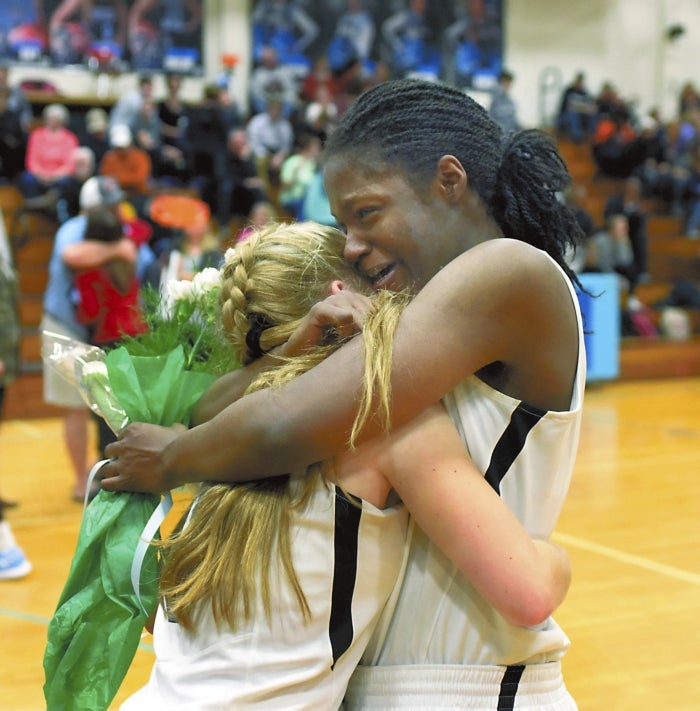Wayne Hinshaw column: Having a bawl
Published 12:00 am Sunday, April 10, 2016

- West 's seniors Taylor Martin and Khaila Hall hug and cry in celebration. photo by Wayne Hinshaw, for the Salisbury Post
“A tear
Hand picked from the clouds of my heart
Providing me with an excellent new start
A tear
Carrying the DNA of pain
Washing away hurtful stains.
(“The Power Of A Tear” poem by Howard Simon)
Watching the men’s NCAA basketball tournament for the past three weeks, I have seen countless young, big, strong men walk away from the hardwood court at the end of the game with tears streaming down their faces. There were not just a few tears on their cheeks, but heavy sobbing.
These modern-day athletes, with the bodies of the ancient Greek gods, “chiseled” from skin and bone, are tough as nails. Their bodies glistening with sweat hot from the competition. Their shoulders and arms marked with tattoos like fierce warriors from the past.
They cried?
I read an article by Mandy Oakland in Time Magazine several weeks ago about about crying. Seeing these basketball players in tears reminded me of her research. She questioned, “How come some people don’t cry at all?”
Charles Darwin once said that emotional tears were “purposeless.”
Old Testament writers thought that “tears originated in the heart.”
During Hippocrates’ time in the 1600s, “emotions — especially love — heated the heart, which generated water vapor in order to cool itself down. The heart vapor would then rise to the head, condense near the eyes and escape as tears.”
We know that funerals, sad movies, sad events in life, marriage breakups and even laughing so hard that we cry can all produce tears. Sometimes, we cry with joy after a new baby is born or we win a ballgame or passed an exam. Most of us cry in private, however. Research shows that females cry about 2-5 times a month, while males only cry once every two months. Our preferred time to cry is 7 to 10 p.m.
Our feelings and human bonding triggers our tears. When we cry, other people can see that we have reached a point where we are having trouble dealing with a problem. Seeing someone cry often causes us to cry, even though we may not know why the other person is in tears. Crying can influence others to show sympathy for us.
In February, West Rowan High senior basketball players Taylor Martin and Khaila Hall hugged and cried tears of joy on the court after a winning a tough game against Hickory Grove to win the regular season championship.
Last September 11, Ellis Assistant Fire Chief Chuck Wetmore became emotional at the 9/11 Memory Ceremony at the Firefighters Memorial. There were no tears but he cried in his heart.
Catawba College’s Carlos Tarots sat alone on the sideline, overcome with emotion after the NCAA season-ending football loss.
Back in 2014, Larrius Cleveland and his son L.J. Cleveland, Jr expressed emotion during lunch at Forest Park Elementary in Kannapollis when Larrius surprised his son when returning from military service in the U.S. Army.
For me personally, I seldom cry. While speaking at my Dad’s funeral, I did break down and cry from the emotional hurt. Until that moment, I had not cried over his death, but at that moment in front of those gathered for the funeral, it hit me hard and I cried. As I looked across the room, others were drying tears as well.
I have seen many tragic events and situations while covering the local news that made me want to cry tears, but I didn’t. To paraphrase the words from a country song, “my heart cried a tear” for the others. I had no tears, but the emotions for tears were in my heart or mind. There was that human emotional connection.
Dutch scientist and photographer Maurice Mikkers said, “Every tear is as unique as a snowflake. It’s very personal.” He studied human tears under a microscope and photographed the dried tears as salt crystals. There are “oils, antibodies and enzymes suspended in the saltwater.” Each tear is different looking, like snowflakes.
He groups tears in three categories: Basic tears that are always in the eye to keep the eye moist. “Reflex tears” are formed when a foreign object enters the eye. “Emotional tears” run down our cheeks when we are sad, angry, upset and sometimes when we laugh or are suddenly very happy — tears of joy.
Other research shows that emotional tears have more protein than basic or reflex tears.
The subject of tears or crying is so universal that it shows up in our art and music often.
Singer Bobby Goldsboro’s song “Honey” made several references to crying.
He sings,
“Came runnin’ in all excited,
slipped and almost hurt herself
And I laughed till I cried”
Later in the song,
“When I came in from working’ late
‘Cause I would know
That she’d been sitting’ there and crying
Over some sad and silly late show
At the end of the song, he sings,
“And a small cloud passes overhead
And cries down on the flower bed
That Honey loved”
There are dozens and dozens of other songs about crying such as Roy Orbison’s “Crying,” Elvis Presley’s “Crying in the Chapel,” Lavern Baker’s “I Cried a Tear,” Bob Dylan’s “Baby Stop Crying,” and Ray Charles’ “Drown in My Own Tears.”
Upon the death of his son, Eric Clapton stopped performing for nine months for grief. When he returned to the stage he and Will Jennings had composed the sone “Tears in Heaven,” trying to release his grief for his son Conor.



